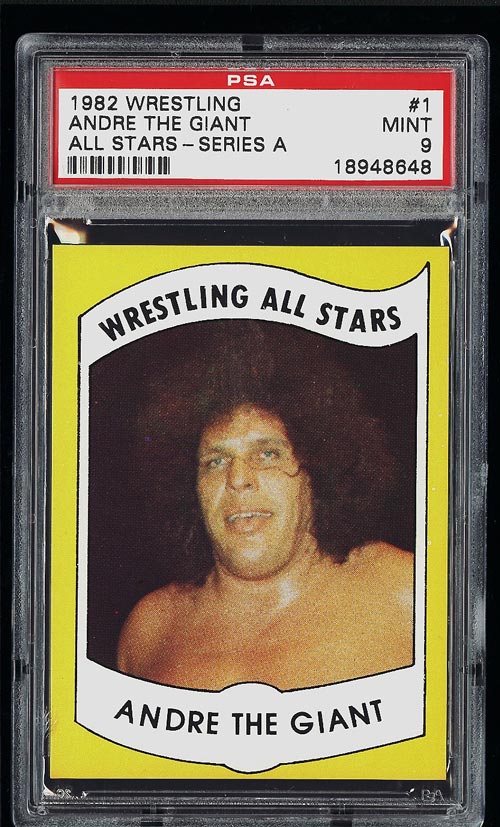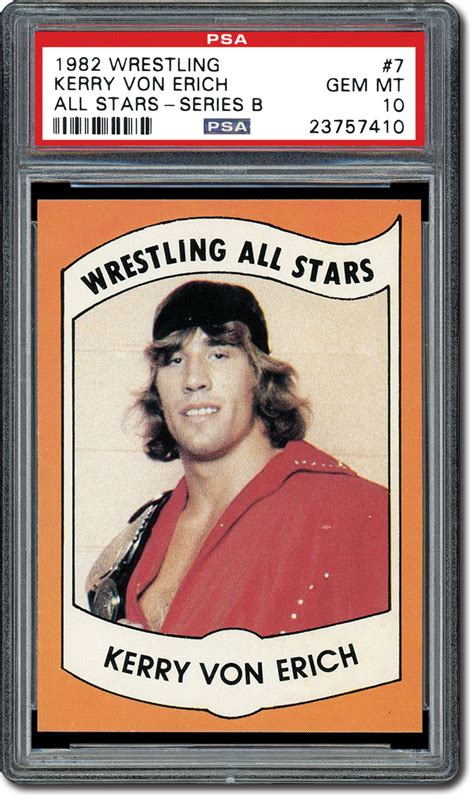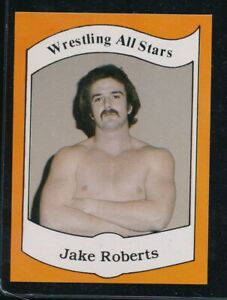
Within the world of sports card collecting, professional wrestling is overshadowed by mainstream sports; the average collector most likely has little, if any “exposure” to wrestling cards in their collection. Despite the niche status that wrestling cards hold, their value should not be discounted. This argument is best evidenced by the 1982 & 1983 Wrestling All Stars set of cards. Consider that commons from either set consistently auction for $8 – $10, which is 10x the value compared to football, hockey, or baseball commons from the same time period.
While the overproduction of sports cards in the late 80s and early 90s serve as a great example of oversupply, the story behind the 1982 & 1983 Wrestling All Stars is an excellent counter example of limited supply and late stage demand, a microcosm of what happened with sporting cards from 1950’s. A brief background helps in understanding the value of the set and also serves as an introduction for those unfamiliar with the 1982 and 1983 Wrestling All Stars.
The Early 1980’s: An Important Transition Period for Professional Wrestling
The early 80’s marked an important transition period for what we now refer to as professional wrestling. Prior to the empire that Vince McMahon built for himself, professional wrestling was very much a regional event, with each state and sometimes county having their favorite set of local wrestling celebrities. There were indeed famous wrestlers back then. Andre the Giant, for example, would tour the US and even the world in the 70’s and early 80’s yet he was still very much a niche name in what was a very niche form of entertainment.
Vince McMahon brought wrestling into the mainstream by hand picking the best regional celebrities along with some organic creations, pitting them against each other in his World Wrestling Federation (WWF). This development coincided perfectly with the advent of cable television, allowing audiences across the entire continent to watch the same events. Prior to cable television, local events were limited to a small audience, if they were even filmed at all. The WWF and its subsequent rival WCW brought wrestling into the mainstream in the mid 1980s, just a few years after the 1982 and 1983 Wrestling All Stars cards were issued.
The 1982 and 1983 Wrestling All Stars card collection dips its toes in both eras of wrestling, new and old, which makes it so valuable and also interesting as a collector’s item. Classic wrestlers such as Ray Stevens, Dick The Bruiser, Fred Blassie and Jerry Lawler find themselves in the set, names that I admittedly knew little about since these wrestlers represented an earlier generation I wasn’t alive to witness.
Mixed into this card collection are the first appearances of some of the biggest names to grace the ring in the late ’80s and ’90s, Hulk Hogan and Andre the Giant being the two best examples and naturally the most valuable cards to own. You also have “rookie” cards, if one can apply the term here, of other well known names that any kid growing up during this time would recognize. A young Ted DiBiase appears in the set before he became the Million Dollar Man; the same goes for the rather generic sounding Jake Roberts, no snake to be found. The set also features the likes of Jesse Ventura, Sergeant Slaughter, the Iron Sheik, Ric Flair, Bobby Heenan, Jimmy Hart, and Dusty Rhodes.
I’ve most likely left out wrestlers that other readers have come across and remember from their childhood, which is why I find this particular set of cards so interesting since it captures audiences from a wide span of generations.
A Brief Background on the 1982 & 1983 Wrestling All Stars Set of Cards

There is no better empirical study of supply and demand than the discussion of sports card collecting. The 1982 / 1983 Wrestling All Stars set of cards hit upon several key aspects of the economic theory. First, unlike most sports cards of this era, these cards were not sold in stores, rather they could only be ordered in the mail from Wrestling News Magazine. As one can imagine, those who subscribed to this magazine were most likely few in number relative to the US population at the time, rarer still were magazine subscribers who ordered the set of cards. According to an article featured on the PSA website, it is estimated that only 2,000 copies of the 1982 Series A and B were ever produced.
Given the above, it should be clear that a limited supply of available sets makes a full collection more difficult to come by. Although sports card collecting was a hobby during this period, we can safely assume that only die hard fans would have preserved a collection, meaning that a portion of those 2,000 sets were lost, damaged, or thrown away, further constraining an already limited supply.
Secondly, because these cards weren’t produced at scale like most sports cards of the time, many of the existing cards have centering errors and are miscut. This is an important consideration. When it comes to grading, cards that are off center carry less value, making the supply of perfectly cut cards limited. One can begin to understand why this set is so desirable: not only is the supply already limited, rarer still is to find a complete set without imperfections.
Third, in a theme that was similar to the baseball card collections of the ‘50s and ‘60s, many of the sets that have made it after 40 years were not preserved well. I’ve seen cards auction with coffee stains or torn edges that still go for a decent price, a testament to the rarity of coming across a perfect set.
Finally, the full set of cards were packaged tightly in cellophane and shipped in the mail. Occasionally, you can still find these sets for sale on Ebay although they are more rare to come by. Because these cards were delivered in the mail, the top card to be packed (Andre the Giant in 1982 Series A and Rick Martell in 1982 Series B) had a greater chance of suffering surface damage such as scratching. Not only did the top card suffer damage, the packing mechanism as a whole has made it more difficult to find unblemished cards. Because these cards were wrapped in cellophane instead of coming in wax packs, corner damage is more prevalent in the series, once again making a perfectly graded card the equivalent of a needle in a haystack.
1982 Wrestling All Stars Series A
There are a total of 3 sets that make up the 1982 and 1983 Wrestling All Stars collection, the first being Series A. This set consists of 36 cards and is by far the most valuable and desired of the triumvirate.
As the title of my post suggests, the 1982 and 1983 Wrestling All Stars series is the top shelf, the creme de le creme, the Rolls Royce of professional wrestling cards. The main reason behind the desirability of this set in particular is that it’s the first to feature some of the most well known wrestling stars from this era: Hulk Hogan and Andre the Giant are obviously the biggest names, even recognized by non-wrestling fans. Additionally, 1982 Series A also includes Ric Flair, Dusty Rhodes, and Ted DiBiase along with some lesser known but still popular figures like Ken Patera, Tony Atlas, and Bruno Sammartino.
As of this writing, you can easily see a medium graded Hulk Hogan card sell for $2,000 and upwards. Andre the Giant and Ric Flair fetch similar prices. I can only imagine what a highly graded set (PSA 8 or higher) would go for but wouldn’t be surprised to see it sell for $45,000.
1982 Wrestling All Stars Series B

Set B obviously doesn’t carry the same prestige as A, which is understandable. How can you top a set that had some of the most famous wrestlers from that time and even to this day? With that said, the 1982 Wrestling All Stars Series B is still quite valuable both due to the limited supply of available sets as well as the many future superstars found in the collection.
Consisting of 36 cards, 1982 Wrestling All Stars Series B happens to contain many stars which would grow in popularity as the WWF and WCW took off in the mid ’80s and ’90s: Rick Martel, Kerry Von Erich, Ricky Steamboat, Paul Orndorff, Tito Santana, Sergeant Slaughter, Bobby Heenan and the Iron Sheik all grace this set.
There are a few points to note about 1982 Series B. First, it’s worth a reminder that Rick Martel was packed first in the set, making it difficult to find one of his cards graded above an 8. Secondly, Kerry Von Erich happens to be a much sought after card due to consistent centering problems with most of his cards, this makes a high grade version of his card extremely difficult to come by.
The 1983 Wrestling All Stars Series

The follow up to the blockbuster 1982 series was 1983 Wrestling All Stars. This is a standalone set, meaning only 36 cards make up the entire series. There seems to have been more copies in circulation than the prior year, making it slightly easier to find these cards. With that said, the set is still rare compared to any other wrestling cards issued during this period.
Like 1982 Series B, it’s difficult to top Series A. Nevertheless, 1983 Wresting All Stars still features a fair amount of heavy hitters for the era: Jimmy Snuka, “Hacksaw” Jim Duggan, Jimmy Hart, “Big” John Studd, Jake The Snake Roberts, and Captain Lou Albano are some of the most recognizable wrestlers to me.
Is the 1982 and 1983 Wrestling All Stars Card Collection a Good Investment?
We are living in strange economic times with the printing press initiated by the Federal Reserve creating price inflation over the past couple of years. Considering interest rates are still extremely low, I don’t see anything wrong with having a portion of your investment portfolio in non-traditional assets like sports cards. Just in the last couple of years, the value of many cards have risen exponentially.
With that said, I strongly advocate following your passions when it comes to card collecting. You will be thoroughly bored investing in any type of card that you don’t have any passion or emotional connection with. It’s also a waste since there are other collectors who would enjoy to have such cards over you.
Collecting wrestling cards is a fun hobby for me first and foremost as it brings me back to my childhood. The fact that it can also be a form of investment plays a role but is secondary. If these cards appreciate in value over time that’s wonderful but the value they hold for me is intangible and difficult to put a price on. I’d say that any serious collector more or less feels the same way.
Goodluck collecting!
February 9, 2022 at 6:00 pm
What do you know about the reprints? I cannot seem to find anything specific that differentiates them from the originals? Any help would be appreciated as I am having a hard time figuring this out.
August 30, 2022 at 12:01 am
Thanks for your question. Reprints are scams to attract new collectors not familiar with the hobby. All they are is a carbon copy of the original and absolutely worthless. Personally, I think Ebay should ban the selling of reprints as they have no value and are specifically designed to swindle collectors.
October 5, 2022 at 9:00 pm
How can you tell between a real card and a reprint card? Thanks
November 3, 2022 at 11:50 pm
Hi Marc, the short answer is that the average collector really can’t. This is where the business of grading comes into play. While it may be too late if you already own the card, you could always have it submitted for grading to be certain, or only purchase graded cards. While this is not always ideal, if you get to know some local card dealers in your area, they can most likely point you to a legitimate seller. Often times card shows are the best places to get such cards as the local dealer community has its own “regulation” since you’ll notice the same sellers showing up month to month at shows. Their reputation is on the line and are far more trustworthy than random Ebay sellers.
February 27, 2022 at 11:28 pm
Hey there, we’re either of these series reprinted? I see 1982 series A cards on eBay marked “reprint”(?)
August 29, 2022 at 11:58 pm
Thanks for your question. Reprints are scams to attract new collectors not familiar with the hobby. All they are is a carbon copy of the original and absolutely worthless. Personally, I think Ebay should ban the selling of reprints as they have no value and are specifically designed to swindle collectors.
July 27, 2023 at 5:06 am
What do you know about uncut sheets I have one in my possession would it alter the worth if I had it cut
September 28, 2023 at 6:34 pm
Hi Ricky,
That’s a rare find. If it is possible to preserve it, my suggestion is to hold onto it. This is so rare to come across I think it would be better to keep it in this condition. I do understand that storing an uncut sheet is more difficult than storing cards so if you decide to cut it, I’d suggest seeking the advice of a specialist.
I would know a couple in the Connecticut area I could refer you to, feel free to send a message on our site contact form if more help is needed.
June 5, 2024 at 8:18 pm
I have been buying cards from these 3 sets on ebay for the last 3 months. I have noticed on ebay there are very few Hulk Hogan or Ric Flair cards on ebay. I can still buy an Andre mid grade card for a fair price. It seems only high grade Hulk or Flair cards are on ebay. It seems lot of original cards were autographed or Trashed. I am trying to put together a set of cards in PSA 6-8 range. I noticed these cards are going for ridiculous amounts at shows. Wheeling and dealing on ebay is my only alternative. I still need about 30 cards total from those 3 sets. Any ideas on how I can acquire these cards other than card shows or ebay? I’m not rich just trying to make some investments. I am a die hard wrestling fan.
February 8, 2025 at 6:55 pm
Hi Tony,
The lack of Hogan or Flair cards could be due to the fact that many fans hold on to them due to their scarcity level and would only sell if money were badly needed or if they were passed on through an inheritance. My fascination with this set is due to the backstory as well as the rarity of the cards but that makes them expensive! Ebay is your best bet due to the size of the marketplace. Because wrestling is very niche you most likely won’t see these cards at most shows. If you do run into them they are most likely going to be priced along Ebay levels or in some cases higher since they are more difficult to offload at shows.
It’s worth highlighting that this is the “top of the shelf” as far as wrestling cards go so it can be very expensive to build even one set. The next tier below would be 1985 Topps followed by 1987 Topps. You may want to consider collecting one wrestler across these tiers as a compromise, or building your first set on the lowest of grading levels as a starting point.